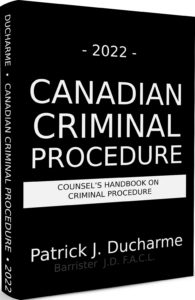 |
| Patrick Ducharme |
For the purposes of bail accused persons are divided into two groups: those that are charged with an offence listed in section 469, and those that are charged with any other offence. Only a Judge of the Superior Court of Justice has the power to release a person charged with an offence listed in section 469 of the Code.1 Rule 20 of the Criminal Proceedings Rules apply. The accused must apply for release. The release hearing does not occur automatically. The procedure used is the same as that required for a normal bail review pursuant to sections 520 or 521 of the Code. A notice of application must be served on the prosecutor together with an affidavit from the accused. The affidavit of the accused must comply with Rule 20.05. To have the accused present at the bail hearing the applicant must obtain a Judge’s order for his attendance.
In any other bail hearing, that is, for any bail hearing where the offence is not listed in section 469, there is an initial presumption that the presiding Justice should order the accused released on the least onerous form of release, namely an undertaking without conditions2 unless the prosecutor shows cause why the accused’s detention in custody is justified or why a more onerous form of release should not be ordered or unless the circumstances are such that the accused has the onus shifted to him to demonstrate why his release is justified in what are known as reverse onus situations.

The above is the an excerpt of Patrick J Ducharme's book, Canadian Criminal Procedure, available at Amazon or in bulk through MedicaLegal Publishing along with Criminal Trial Strategies.
Subscribe to Patrick Ducharme's Youtube Channel
